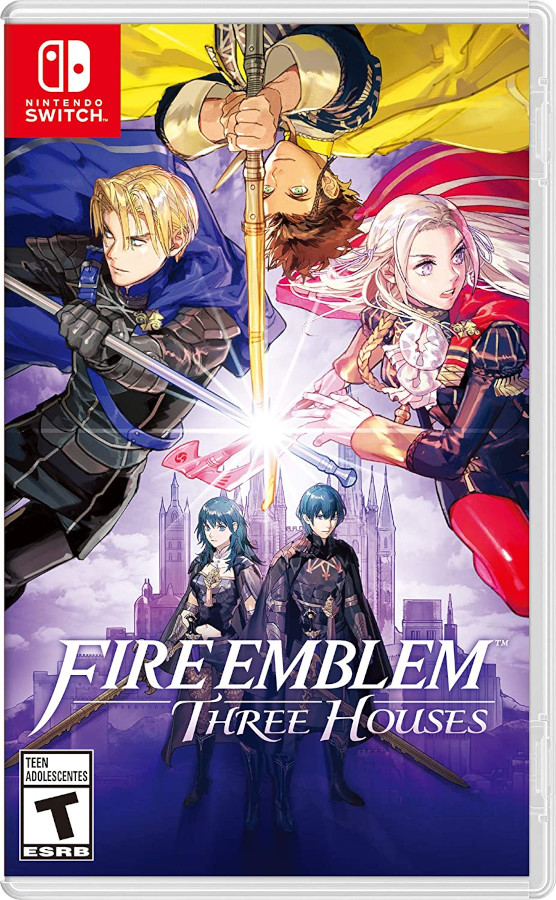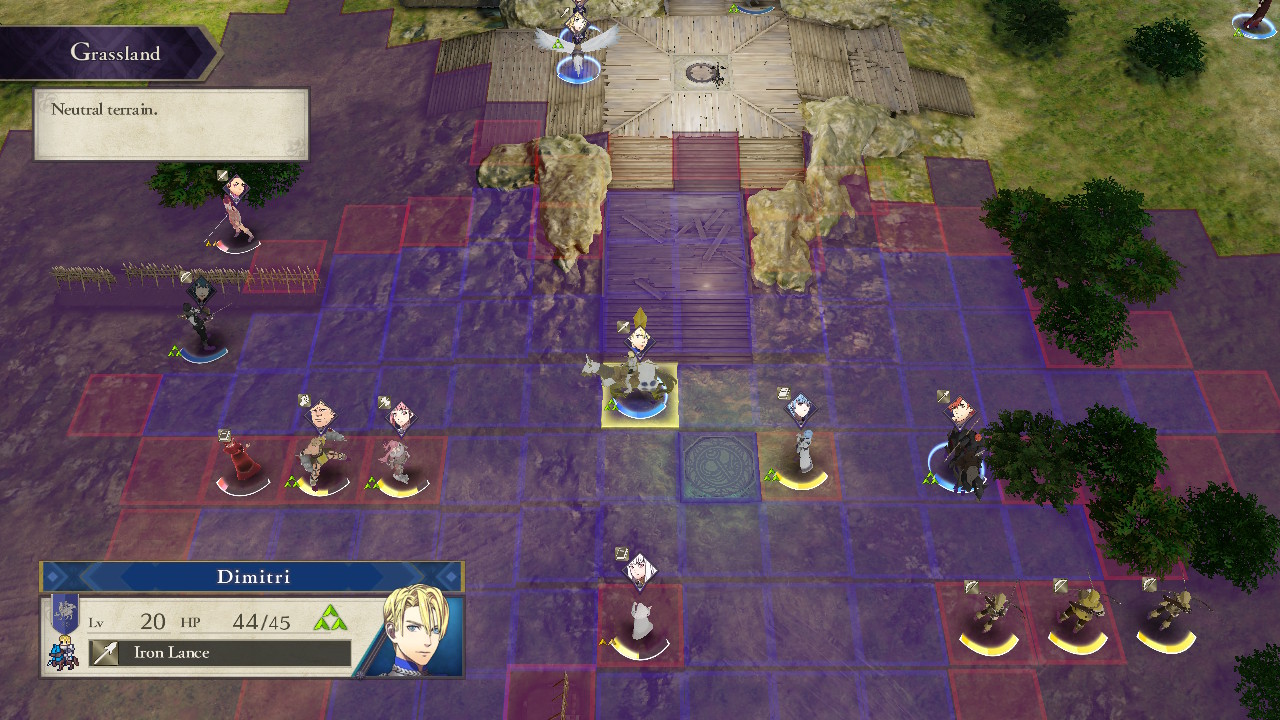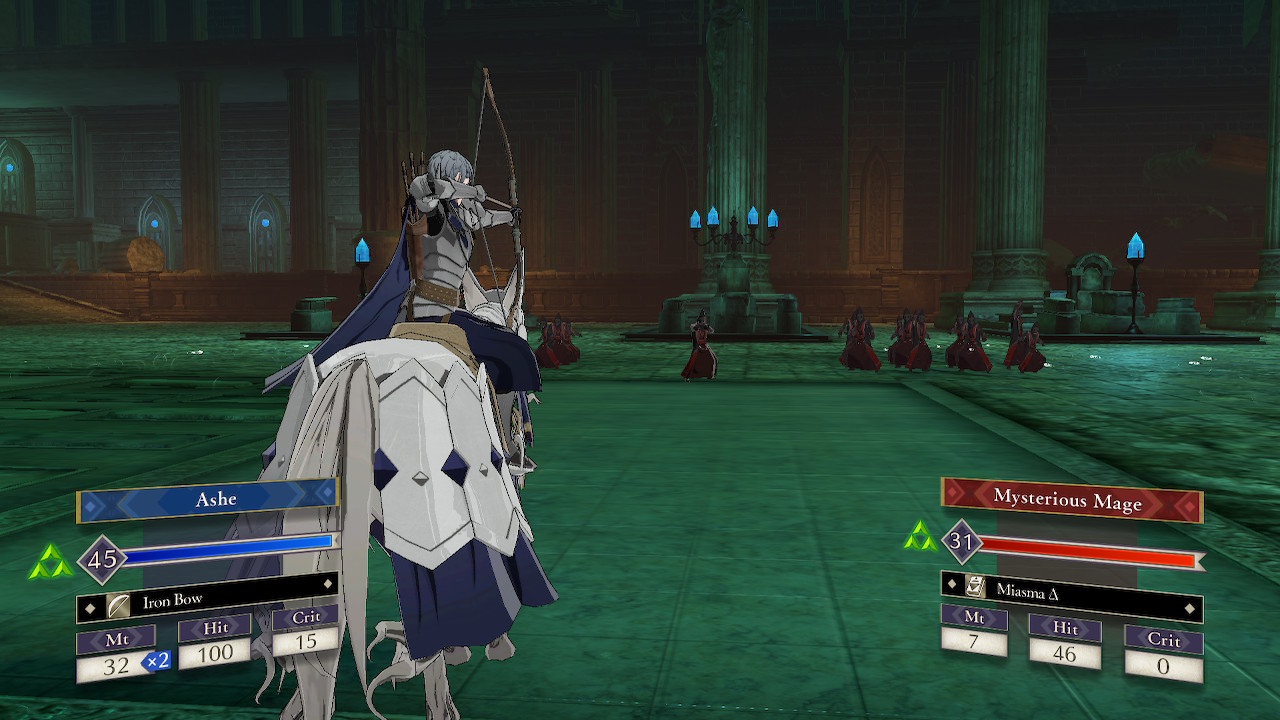Search
[{{{type}}}] {{{reason}}}
{{/data.error.root_cause}}{{{_source.title}}} {{#_source.showPrice}} {{{_source.displayPrice}}} {{/_source.showPrice}}
{{#_source.showLink}} {{/_source.showLink}} {{#_source.showDate}}{{{_source.displayDate}}}
{{/_source.showDate}}{{{_source.description}}}
{{#_source.additionalInfo}}{{#_source.additionalFields}} {{#title}} {{{label}}}: {{{title}}} {{/title}} {{/_source.additionalFields}}
{{/_source.additionalInfo}}- Details
- Category: Switch
- By Tyler Ferguson
- Hits: 2125
Fire Emblem: Three Houses (Switch)

Fire Emblem: Three Houses
Developed By: Intelligent Systems
Published By: Nintendo
Released: July 26, 2019
Available On: Switch
Genre: SRPG
ESRB Rating: T for Blood, Violence, and Suggestive Themes
Number of Players: 1 offline
MSRP: $49.99
(Amazon Affiliate Link)
Like many in the West, my first exposure to Fire Emblem was through Super Smash Brothers, where I noticed several blue-haired and red-haired swordsmen that I didn’t recognize. I learned that these characters belonged to a series called ‘Fire Emblem.’ After I learned of the series, I ignored it for many years, only recently giving it a shot with Fire Emblem: Three Houses.
Fire Emblem: Three Houses takes place in Fódlan, a continent formed of three nations living in a fragile peace under the authority of the Church of Seiros. You walk in the shoes of a customizable mercenary. (You can choose if the mercenary is male or female, and you can choose his or her name.) One day, a mission ends up leading you to the Church of Seiros, where the mysterious archbishop coerces you into teaching at the church’s Officer’s Academy. During this school year, you are tasked with teaching one of three classes, each corresponding to one of the nations.
Fire Emblem: Three Houses is a strategy role-playing game, or SRPG for short. You command a miniature army (usually consisting of ten to twelve units) against a force of AI-controlled enemies. Taking turns with the enemy, you can move your units on a grid-based map, usually with the goal of wiping out every enemy or defeating a specific target.
To attack, you simply move a unit next to or near an enemy and select a weapon to attack it with. There are plenty of types of units which are proficient with different weapon types. Units with swords or lances can deal and resist a lot of damage, but are limited in their range; archers can use their bows to easily defeat air-born and far-away units, but will easily die if attacked at close range; armored units are impervious to most weapons, but are extremely vulnerable to mages.
While the combat is relatively easy to pick up and learn, it is still really fun and requires a lot of thinking and planning. Failure to carefully plan out each move (such as where to move a unit, and which enemies will attack it) will quickly lead to the deaths of your units. As is tradition for Fire Emblem, units who fall in battle are lost forever, though there is an option to disable this.
Some new additions to the combat include equippable Combat Arts and battalions. Combat Arts are special attacks units can perform when using compatible weapons, allowing for extra damage when used in the right situations. Similarly, battalions can be assigned to units to allow them to perform a very powerful attack that damages multiple enemies once or twice per battle. I rarely used Combat Arts, as opportunities to use them effectively seldom appeared. Battalions are significantly more useful, as they can counter the new monster enemies that take up several tiles on the grid.
Some preparations you must perform include keeping everyone’s weapons up to date (as they have durability), along with managing equippable perks, Combat Arts, and battalions. Unfortunately, all this preparation takes far more time than it should. (I found myself spending upwards of ten minutes managing units before each story mission.)

Strong Points: Strategic RPG combat; great story in one path
Weak Points: Far too repetitive if playing all paths; awful graphics and framerate
Moral Warnings: Minor violence during gameplay using weapons like swords; especially violent cutscenes with blood; practically necessary use of magic; game revolves around a church with a fictional goddess, which is portrayed as good or evil, depending on your choices; uses of words like h*ll, d*mn, crap, and b*****d; characters occasionally blaspheme fictional gods (though not the real God); mentions of alcohol and gambling; one character known for skirt-chasing; revealing designs for some female characters; marriage mechanic that allows for same-sex and underage "marriage," along with the ability to "marry" someone who is technically your grandmother; several cases where the game avoids referring to you as a boy or girl
While the story starts out very simple, it becomes very interesting partway through. It also changes depending on which house you selected to teach, along with a choice you can make if you pick a specific house, resulting in four total paths. I picked the Blue Lions house in my first playthrough, which led to an amazing story in the second half of the game. I expected every route to be given an equally intriguing story, but I was quite mistaken. Three of the four routes are rather similar, and two in particular are nearly identical. And none of the other routes, save for the Blue Lions path, have especially interesting stories.
Unfortunately, the repetition also extends to the gameplay. For starters, the first eleven chapters are nearly identical, regardless of which house you pick at the beginning. This means playing the same missions at least three times if playing through every route. Even when the story does split based on your choices, most of the missions are practically copy-and-pasted between routes. All the time spent preparing at the monastery felt especially repetitious the more I played, leading me to hardly prepare at all for upcoming battles in my later playthroughs.
Though I was excited to play Three Houses multiple times to experience everything, I was very disappointed to see how similar all the paths really are. (It doesn’t help that each path can take around 60 hours if you don’t skip optional content.) I would recommend picking the Blue Lions house for the best story, and only playing through every path if you feel like replaying the game anyway.
Fire Emblem: Three Houses has an anime art style, but its art style stands out from the plethora of generic anime games. While the art style is fine, the overall visuals are not. During cutscenes, characters all have the same dead stare, only interrupted by slow, creepy blinking. The monastery suffers from the most unstable frame rate I have ever seen! NPCs sometimes pop in seconds after standing next to them! As Three Houses uses the Warriors engine, it is not surprising that the environments during battles look like they were taken out of a Warriors game. Because of this, they look incredibly empty and bland.
Fire Emblem: Three Houses has an incredible amount of dialogue, from story cutscenes, to NPCs in the monastery, to hundreds of optional cutscenes between characters. It’s impressive that practically every line is voiced. The voice work itself is pretty good, though I’ve noticed a few lines with poor direction or volume so low that the music overshadows them. The music is also really good. The battle themes often use electronic instruments (which work surprisingly well for a medieval fantasy setting) while more serious themes incorporate choirs.
Aside from the poor frame rate in the monastery, I haven’t experienced many issues with Three Houses’ stability. The only glitch I came across was one which prevented units from switching from bows to other weapons when attacking an enemy, depending on how I selected the enemy.
As has become standard for recent Nintendo games, there is a $25 expansion pass. It adds five units you can use, a few minor features (such as maid and butler outfits, for some reason), and most notably, an extra story called Cindered Shadows. While the seven chapters included in this story make for a fun challenge, the actual story is entirely forgettable. And as far as I am aware, it isn’t even canon, making it feel pointless. In short, the DLC is not worth the asking price of $25.

Higher is better
(10/10 is perfect)
Game Score - 76%
Gameplay - 16/20
Graphics - 4/10
Sound - 9/10
Stability - 4/5
Controls - 5/5
Morality Score - 43%
Violence - 4/10
Language – 2.5/10
Sexual Content – 2.5/10
Occult/Supernatural – 6.5/10
Cultural/Moral/Ethical - 6/10
The combat involves using weapons like swords, axes, and bows to kill enemies, which are usually humans, though monsters are sometimes fought as well. That said, when enemies die, they simply fall to the ground and disappear. Of the few pre-rendered cutscenes, some are rather violent. One depicts a character being repeatedly stabbed, one shows a character being choked to death (accompanied by the sounds of bones breaking), and another shows slain corpses and a character caked in blood.
As mentioned earlier, one of the weapon types is magic. Magic is used both defensively (such as to heal units) and offensively. The farther you progress, the more important magic becomes, as it is the only easy way to deal with armored enemies. Considering that players have managed to beat the game while using only the protagonist (who primarily uses swords), I won’t go as far as to say that it’s impossible to avoid magic use, but it is highly impractical. Magic circles appear when characters use magical attacks (though no pentagrams). There are also numerous uses of rituals in the story, even if you do try to put a stop to many of these.
Of course, Three Houses revolves around a church. Though this church follows a made-up religion about a made-up goddess, it is clear that the Catholic church served as its inspiration. It is generally portrayed in a positive light, though there is a big exception. One of the four routes can be considered an “anti-religion” route. In this path, your goal is to take over Fódlan to destroy the church and outlaw religion. Even though the church is supposed to be portrayed as evil in this path, it is clear that you are killing innocent people for the crime of supporting it.
It is not uncommon for characters to use words like h*ll, d***, or crap. I also recall one use of the word b****d. While the true God’s name is never used in vain, there are a few cases where characters will say something along the lines of, “Oh gods,” cursing out fictional gods.
Some characters are known for dealing with various issues, such as alcohol or gambling. One in particular is a womanizer. Nearly every one of his lines has something to do with women, and optional cutscenes involving him show him hitting on women. (I won’t lie, it is really funny seeing him get in trouble because of his actions.) A number of female characters also wear revealing outfits.
As is now tradition for Fire Emblem, it is possible for you to pick one of your units to marry. Like the entries which came before it, Three Houses' marriage system unfortunately allows for plenty of immoral marriages. You are given the option to "marry" plenty of characters of the same sex, one character who could be considered your grandmother (though the game never explicitly says she is related), and a girl who appears to be very young (though it is implied that she is 1,000 years old). At the very least, this feature can be completely ignored, though there are cutscenes outside of this mechanic where characters imply that they are homosexual.
It is also worth noting how the game refers to your gender. When you choose a gender, you are told to “select a form,” and any voiced dialogue that refers to you in the third person calls you a ‘they’ (though unvoiced text calls you a he or she, depending on what you selected).
In spite of its many, many moral issues, Fire Emblem: Three Houses is really fun SRPG, and it remains my favorite in the series after going back to play some of the previous entries. I am disappointed in the similarity of its several paths and the repetition of its gameplay, but as long as you can get over the moral problems, I still think the suggested $60 price tag is worth it even if playing the game only once.
-Tyler Ferguson




